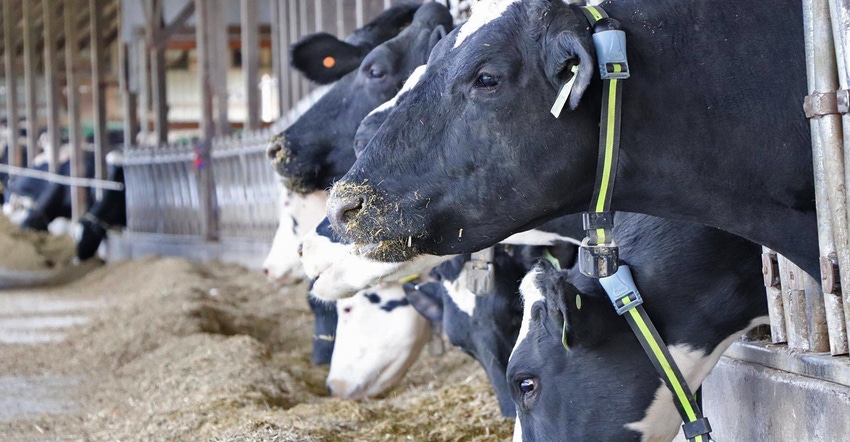
Weaker dairy product prices have pushed milk prices lower. The Class III price peaked in November at $16.88 and fell to $14 in January. It will be $13.50 in February.
“It looked like the Class III price would stay in the $13s at least through March,” says Bob Cropp, University of Wisconsin Extension dairy economist. “But the good news is cheese prices have improved during February, and if they hold or improve more, the Class III price could reach about $14.25 in March.”
At the Chicago Mercantile Exchange, barrels averaged $1.33 per pound in January but strengthened during February, reaching $1.49. The 40-pound block price averaged $1.49 per pound in January and also strengthened during February, starting at $1.46 and hitting $1.55. However, the price of dry whey remains weak at around 25 cents per pound, not adding strength to the Class III price.
The Class IV price may show only modest improvement in March, to near $13.40. Butter, which averaged $2.15 per pound in January, has held in the low $2s and will average about the same in February.
Dave Kurzawski, senior broker at INTL FCStone in Chicago, echoes Cropp’s comments. “I think milk prices have bottomed out,” he says. “Milk prices are turning around.”
Kurzawski says there are three main reasons why milk prices will soon begin improving.
1. Issues with available labor and increasing costs are intensifying while producers deal with compressed margins.
2. The removal of rBST, a product many farmers used to boost milk production, continues.
3. Demand for milk solids is picking up globally. This is perhaps the single-largest driver of upside potential.
“We had low demand globally for dairy products in 2017,” Kurzawski explains. “Global dairy demand was up 1.7% last year. Strip out China from that number, however, and that number drops to a 1.1% decline in global demand. We’re not going to have back-to-back years of low demand, especially with 3% growth in the economy. The turnaround is not going to happen overnight, but we expect milk prices to be improving by the end of the first quarter.”
While stock levels have improved, there are ample stocks to dampen increases in dairy product prices. Dairy product production has been running well above a year ago. Compared to December a year ago, increases were: butter, 4.2%; American cheese, 2.9%; cheddar, 3.2%; total cheese, 2.6%; dry whey, 6.1%; and nonfat dry milk, 5.4%.
Dairy exports jump
“Reports are that butter and cheese sales have picked up,” Cropp says. “Dairy product prices have also been helped by dairy exports.”
U.S. dairy exports finished 2017 strong. Compared to December a year ago, exports of nonfat dry milk/skim milk powder were 27% higher, while cheese was 4% lower; exports for the year were 19% higher, butterfat exports were 18% higher, and dry whey was 9% higher. On a total solids basis, December exports were equivalent to 16.4% of milk production, compared to 14.5% a year ago. That was the highest level for U.S. dairy exports since 2014, according to USDA’s Foreign Agricultural Service. Leading markets for U.S. dairy exports in 2017 were Mexico, up 8%; Canada, up 1%; China, up 49%; Japan up 41%; South Korea, up 21%; Philippines, up 7%; and Australia, up 70%.
“How milk prices play out from here will, of course, depend on the level of milk production, domestic sales and exports,” Cropp says.
USDA has lowered its increase in 2018 milk production from 1.8% to 1.5%. USDA forecasts the average number of milk cows for the year to increase slightly to 0.2%, which is reasonable considering low milk prices will likely result in some producers exiting and a slowdown in dairy expansions.
“So we can expect milk prices to continue to improve as we move through the year, especially if the increase in milk production does stay well below 2%,” Cropp says. “However, USDA’s latest milk production report estimates January milk production to be up relatively high from a year ago, with a 1.8% increase.”
Last year butter and cheese sales had only a modest increase. But with continued growth in the economy and a higher Consumer Confidence Index and Restaurant Performance Index, the sales growth this year could be stronger, he says. Dairy exports will face strong competition this year, particularly from the European Union. Milk production is increasing in the EU, and increased exports of cheese and skim milk powder are expected to compete with the U.S. for markets.
“As of now, the dairy outlook appears a little brighter than it did in January,” Cropp says. Class III dairy futures continue to improve, reaching the $15s by July and the low $16s by October, with an average of about $15 for the year.
“I could see a similar price pattern, if not even a little higher the last half of the year, if the increase in milk production remains well below 2% and dairy exports still show growth in 2018,” Cropp says. “But the Class III will still average well below the $16.17 average last year.”
O’Leary is editor of Wisconsin Agriculturist.
About the Author(s)
You May Also Like






